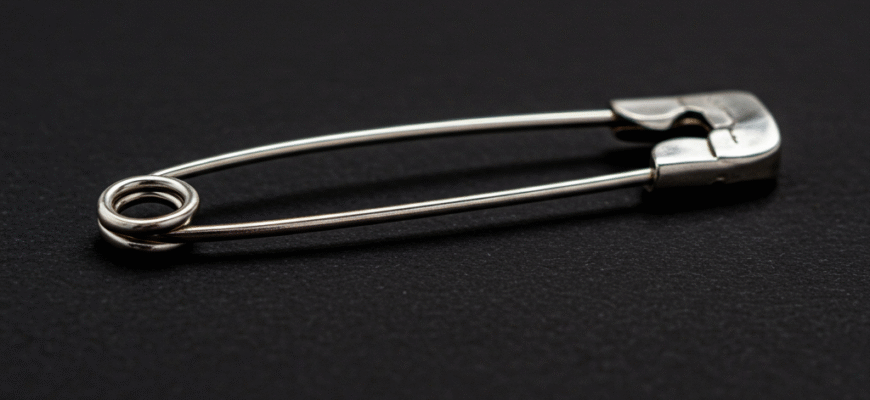Content
The Accidental Genius of Walter Hunt
The story of the safety pin’s birth is almost as unassuming as the object itself. In 1849, an American mechanic named Walter Hunt was fiddling with a piece of brass wire. He wasn’t aiming to revolutionize fastening technology; he was trying to figure out a way to pay off a $15 debt (a not insignificant sum at the time). As he twisted the wire, inspiration struck. He realized that by creating a coil at one end to act as a spring, and a clasp or cap at the other to cover the sharp point, he could create a pin that held securely and protected the user from its own point. The design was remarkably elegant in its simplicity: a single piece of wire, cleverly bent. It featured a coiled spring mechanism, a pointed arm for piercing fabric, and a crucial guarded clasp that shielded the sharp tip once fastened. This guard was the key innovation – it prevented the pin from accidentally opening and, more importantly, protected the wearer and anyone nearby from the point. Hunt patented his “dress pin,” as he called it, on April 10, 1849 (U.S. Patent No. 6,281).Walter Hunt, a prolific inventor with creations like a sewing machine, a fountain pen, and a streetcar gong to his name, reportedly sold the patent rights for his safety pin for just $400. This seemingly small sum addressed his immediate debt but paled in comparison to the vast fortune the invention would eventually generate for others. Hunt’s focus was often more on the act of invention than on commercialization.
Immediate Impacts on Dress and Care
The safety pin’s arrival wasn’t just a minor convenience; it fundamentally altered daily routines, particularly concerning clothing and childcare.Clothing Security and Repair
Suddenly, people had a fast, reliable, and safe way to fasten garments. Think about securing wraps, shawls, or loose-fitting clothing. Wardrobe malfunctions – a popped button, a ripped seam, a hem coming undone – could now be addressed quickly and discreetly on the spot. It provided a temporary but effective fix, saving countless individuals from minor embarrassments or the need for immediate, more involved repairs. Tailors and seamstresses also benefited, using safety pins to hold fabric pieces together during fitting and construction, replacing the less secure straight pins.A Revolution in Baby Care
Perhaps one of the most significant impacts was on infant care. Before the safety pin, cloth diapers were typically fastened using straight pins, posing a constant risk of pricking the baby or the caregiver. The invention of the safety pin offered a dramatically safer alternative. Large, sturdy safety pins specifically designed for diapers became ubiquitous. They held the cloth securely, withstood movement, and significantly reduced the danger of accidental injury. This simple device brought peace of mind to parents and made the already demanding task of infant care considerably less hazardous.Beyond the Wardrobe: Versatility Unleashed
The utility of the safety pin quickly extended far beyond just holding clothes together. Its simple, secure fastening mechanism found countless applications around the home and in various activities.- Household Fixes: Need to temporarily hold a torn curtain lining? Secure a loose piece of upholstery? Keep pairs of socks together in the laundry? The safety pin became the go-to tool.
- Organization: Small items, like keys or buttons, could be looped onto a safety pin for safekeeping or easy attachment. Race bibs are still commonly attached to athletes’ shirts using safety pins.
- Crafting and Hobbies: Crafters embraced the safety pin for holding pieces of projects together, stringing beads, or even incorporating them into jewelry and decorative items.
- Emergency Kit Staple: Its usefulness in securing bandages (without providing medical advice, simply holding gauze in place) or rigging temporary repairs made it a valuable addition to first-aid and emergency preparedness kits.
A Symbol of Defiance and Solidarity
Interestingly, this utilitarian object also took on powerful symbolic meanings. In the 1970s, the burgeoning punk rock movement adopted the safety pin as an anti-fashion statement. Punks wore safety pins piercing their clothes, and sometimes even their skin, as a symbol of rebellion against mainstream consumer culture and societal norms. It was a deliberate use of a mundane object in a provocative way, signifying DIY ethics and a rejection of the establishment.While the safety pin became an iconic part of punk aesthetics, its use as a piercing carried obvious health risks. This appropriation highlighted the pin’s inherent sharpness alongside its fastening function. It transformed a symbol of safety into one of deliberate, visible defiance.More recently, following certain political events, some people began wearing safety pins visibly on their clothing as a sign of solidarity with marginalized groups perceived to be at risk. It was intended as a quiet signal that the wearer was a safe person to turn to, an ally against prejudice and discrimination. Though the effectiveness and interpretation of this gesture were debated, it demonstrated the safety pin’s enduring capacity to convey meaning beyond its practical function.









